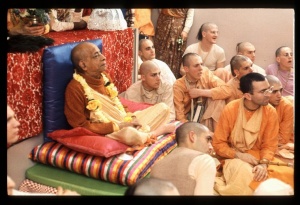CC Antya 3.151 (1975): Difference between revisions
(Vanibot #0027: CCMirror - Mirror CC's 1996 edition to form a basis for 1975) |
(Vanibot #0020: VersionCompareLinker - added a link to the Version Compare feature) |
||
| Line 2: | Line 2: | ||
<div style="float:left">'''[[Sri Caitanya-caritamrta (1975)|Śrī Caitanya-caritāmṛta (1975)]] - [[CC Antya (1975)|Antya-līlā]] - [[CC Antya 3 (1975)|Chapter 3: The Glories of Śrīla Haridāsa Ṭhākura]]'''</div> | <div style="float:left">'''[[Sri Caitanya-caritamrta (1975)|Śrī Caitanya-caritāmṛta (1975)]] - [[CC Antya (1975)|Antya-līlā]] - [[CC Antya 3 (1975)|Chapter 3: The Glories of Śrīla Haridāsa Ṭhākura]]'''</div> | ||
<div style="float:right">[[File:Go-previous.png|link=CC Antya 3.150 (1975)|Antya-līlā 3.150]] '''[[CC Antya 3.150 (1975)|Antya-līlā 3.150]] - [[CC Antya 3.152 (1975)|Antya-līlā 3.152]]''' [[File:Go-next.png|link=CC Antya 3.152 (1975)|Antya-līlā 3.152]]</div> | <div style="float:right">[[File:Go-previous.png|link=CC Antya 3.150 (1975)|Antya-līlā 3.150]] '''[[CC Antya 3.150 (1975)|Antya-līlā 3.150]] - [[CC Antya 3.152 (1975)|Antya-līlā 3.152]]''' [[File:Go-next.png|link=CC Antya 3.152 (1975)|Antya-līlā 3.152]]</div> | ||
{{CompareVersions|CC|Antya 3.151|CC 1975|CC 1996}} | |||
{{RandomImage}} | {{RandomImage}} | ||
==== TEXT 151 ==== | ==== TEXT 151 ==== | ||
| Line 25: | Line 24: | ||
<div class="translation"> | <div class="translation"> | ||
When the Durgā-maṇḍapa and courtyard | When the Durgā-maṇḍapa and courtyard were filled with crowds of men, Rāmacandra Khān, who was inside the house, sent his servant to Lord Nityānanda. | ||
</div> | </div> | ||
Latest revision as of 01:05, 27 January 2020

A.C. Bhaktivedanta Swami Prabhupada
TEXT 151
- aneka loka-jana saṅge aṅgana bharila
- bhitara haite rāmacandra sevaka pāṭhāila
SYNONYMS
aneka—many; loka-jana—crowds of people; saṅge—accompanied by; aṅgana—the courtyard; bharila—became filled; bhitara haite—from inside; rāmacandra—Rāmacandra Khān; sevaka—servant; pāṭhāila—sent.
TRANSLATION
When the Durgā-maṇḍapa and courtyard were filled with crowds of men, Rāmacandra Khān, who was inside the house, sent his servant to Lord Nityānanda.
PURPORT
In those days, and also even now, the palatial buildings of respectable people, especially in the villages of Bengal, were divided into two parts. The inside part was especially meant for the family, and the ladies would live there unexposed to men. That part was called the bhitara-bāḍi, or inside house. In the outside house, or bahir-bāḍi, the respectable gentleman received visitors and kept his business office. The Durgā-maṇḍapa would be part of the outside house. Thus when Lord Nityānanda entered the outside house, Rāmacandra Khān was in the inside house with the members of his family. When Nityānanda Prabhu arrived, Rāmacandra Khān did not receive Him personally but sent his servant to inform Him indirectly to go away.